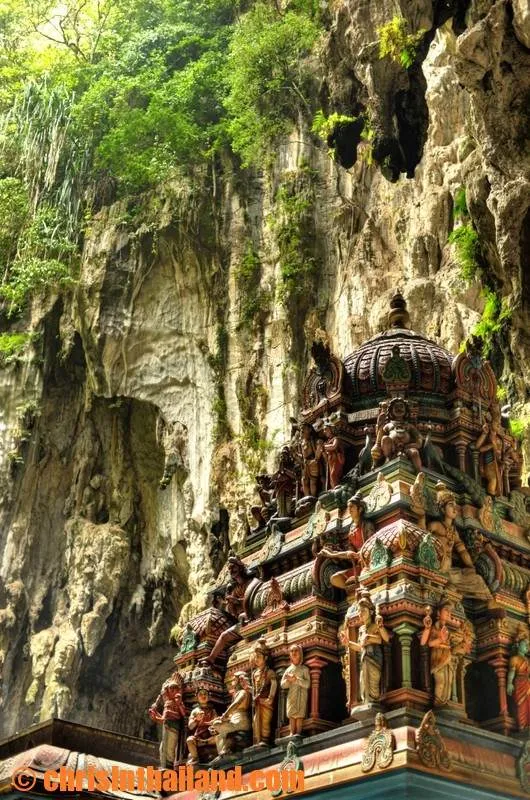
272 steps. There’s no elevator, and no other way up. Just left foot, right foot, left foot, right foot…
While some distance from central Kuala Lumpur, one of Kuala Lumpur’s most mainstream tourist attractions is also one of the easiest to reach. It’s good enough as a layover stop, but is also a perfectly good destination in those hours before you have to make your flight out.
Originally the shelters of the indigenous Temuan people, the limestone caves became famous after being recorded by the colonial authorities in 1878. It was an Indian trader, K. Thamboosamy Pillai, that was inspired to dedicate a temple to Lord Murugan inside, and in 1892, the Thaipusam festival began their celebrations here every January / February. The first wooden stairs were put in place in 1920, and have long been replaced by concrete stairs.

Claiming to be the world’s tallest Murugan statue, the 42.7-meter tall statue was dedicated in January 2006. In case you majored in something other than Hindu deities, Murugan is an ardent devotee of Rama and a central character in the Indian epic Ramayana.
In any case, you can see here what you came to see — you have a Hindu shrine, what amounts to an animal preserve, a limestone cave that’s likely 400 million years old, and a decades-old tourist trap that’s wrapped up into one big ball of intrigue. Enjoy the Hindu shrine (take off your shoes!) you might otherwise pass by without pausing to satiate your curiosity. Pass by the vendors of cheap jewelry and the ‘art gallery’, complete with an admission fee.

Did I mention those 272 steps? In my apartment building, there are 14 steps to travel between one floor and the next — a bit of math reveals you’ll climb about 19 1/2 floors to reach the top. Whoever installs the escalator can charge a fair bit to ride it…

The view, and the caves, makes it worth the inevitable huffing and puffing. Reaching the top qualifies you to enjoy some of the souvenirs some locals some huffed and puffed up the stairs themselves.


I do wish there were a bit more explanation for the average tourist, but the Hindu temples definitely stand out from the caves. Thanks to Wikipedia for telling us the shrine’s general stories are of Lord Murugan’s victory over the demon Soorapadam.

You really do feel rather small in places like these — the walls are hundreds of meters high.

A close-up of some of the scenes near the temple area.
You could spend the rest of the day at the top of the hill, staring open-jawed at the ceilings and walls. You’ll notice that a few of the outlying areas are closed off — not sure of the full story here, but it’s clear they’re not for Joe Public to explore.

OK, so after the wonderful views and peaceful reflections, it’s time for something rather different. Walk back down a few dozen steps and look right for a gate and opening — in short order, you’ll discover the entrance to the Dark Cave. The English signs proclaim the cave being the home to the rarest spider in the world (the Liphistius batuensis, AKA the Trapdoor spider), but being a dark cave would make it rather difficult to get any decent photos short of a tripod. Then there’s the price — 35 ringgit for a 45 minute ‘educational’ tour, or 80 ringgit for a 3–4 hour ‘adventure’ tour, advance registration required. Considering admission to the cave is free, this seems a rather high price to pay…

Aww, the pwetty wittle monkeys. Much like the crab-eating macaques seen in Thailand, their grubby little hands can — and will — try to get ahold of anything that looks like it could be edible. They navigate the stairs with ease, and are found by the dozens in the trees along the stairs.
It was here that a Vanilla Coke and I involuntarily parted ways. I was taking pictures of a couple of monkeys walking along the railing. Aware that a few monkeys were circling behind us, I swung around to scare them off, and the next thing I knew it wasn’t in my backpack pocket… The slick plastic bottle got dropped into the trees, and I never saw it again… Seconds later, my water was grabbed as well. We did at least enjoy watching the monkeys try to figure out how to open the bottle — surprisingly, it only took them a couple of monkeying-around minutes to bite off the lid.
Down at ground level, the monkeys and pigeons competed for attention from the humans with food. More than a few people seemed to pack things specifically for them, but you can easily find them for sale.
I do wish there was a bit more information around — understanding the context of a place is something too commonly left to internet sources when there are opportunities to educate and share right there on-site.
Name: Batu Caves (Batu Kentonmen)
Address: Jalan Batu Caves, 68100 Jalan Batu Caves, Selangor, Malaysia (GPS: 3.24000,101.68067)
Directions: From KL Sentral, get on the Port Klang line (this is a KTM Komuter train, by the way). The Batu Caves are the northern terminus of the line, and not every train goes all the way — double-check the signs or ask the staff to be sure. Once off the train, head out the exit — the entrance is a few minutes walk along a well-trodden route.
Hours: 7am to 9pm. The guided tours are offered from 10am to 5pm (10:30am to 5:30pm weekends and holidays, closed Mondays)
Admission: free admission — ignore the Art Gallery at 15 ringgit, and definitely ignore the Dark Cave Tour at 35 ringgit for the 45 minutes ‘educational’ tour.
Phone: +60 16–333 7328
Website: http://www.tourism.gov.my/en/my/Web-Page/Places/States-of-Malaysia/Selangor/Batu-Caves


